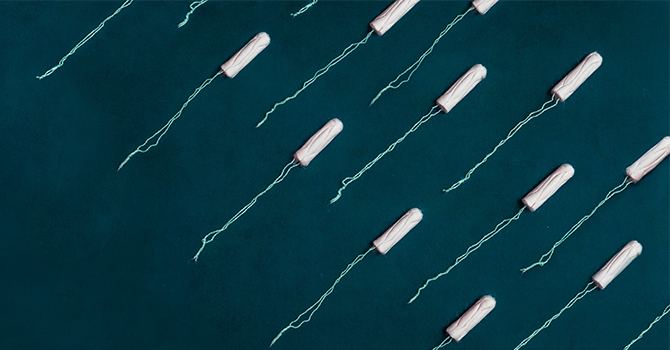Changing the Cycle: Period Poverty as a Public Health Crisis

Ashley Rapp and Sidonie Kilpatrick
Master's Students in Epidemiology
With 1 in 5 girls missing school due to lack of menstrual products1, period poverty is an important, yet often ignored, public health crisis. “Period poverty” refers to the prevalent phenomena of being unable to afford products such as pads, tampons, or liners to manage menstrual bleeding. In lieu of sanitary products, many people are forced to use items like rags, paper towels, toilet paper, or cardboard. Others ration sanitary products by using them for extended amounts of time. Period poverty encompasses not only this lack of access to products, but also inadequate access to toilets, hand washing receptacles, and hygienic waste management.
Access to menstrual products is a right, and feeling clean, confident, and capable during one’s period is a necessity. We can all work toward menstrual equity, and the opportunities are boundless.
Period poverty especially prevents low-income menstruators from bleeding with dignity. While many people know that a luxury tax is still applied to menstrual product sales in Michigan, it is also important to note that products are ineligible for coverage under food stamps and SNAP benefits. This leaves people with the choice between buying tampons or providing other necessities for their family, an effect that is amplified when inadequate menstrual management prevents menstruators from going to job interviews, attending school, or taking their children to educational or social programming.
When menstruators resort to unhygienic alternatives, they are vulnerable to harmful physical and mental outcomes. Products like rags, paper towels, and reused pads put menstruators at a heightened risk for urogenital infections, such as urinary tract infections and bacterial vaginosis2. These products are also associated with outcomes such a skin irritation, vaginal itching, and white or green discharge3. Further, the emotional toll accompanying lack of access is related to poor mental health outcomes, such as elevated anxiety, depression, and distress scores4.
It is essential that when we talk about period poverty, we keep in mind that not all menstruators are women, and not all women menstruate.
The reason this public health crisis is yet to be addressed is largely due to stigma. Stigma associates menstruation with uncleanliness and disgust instead of recognizing it as biologically healthy and normal. The shame associated with periods prevents people from talking about it, which in turn averts dialogues about access to products, the tampon tax, and even the ingredients in our pads and tampons. Shame also surrounds the experience of menstruating as a trans person. It is essential that when we talk about period poverty, we keep in mind that not all menstruators are women, and not all women menstruate. This comes up when only insertion-based products are available in restrooms, when restrooms don’t have product disposal receptacles in stalls, and even in situations where products are available for free, but a person must ask a gatekeeper--like an administrator or teacher--for access to the product.
Access to menstrual products is a right, and feeling clean, confident, and capable during one’s period is a necessity. We can all work toward menstrual equity, and the opportunities are boundless. Whether it’s writing to representatives, advocating for free products in our schools, spreading period positivity on social media, or hosting donation drives for menstruators in need, every action has a ripple effect. Coalitions of advocates each making even the smallest of ripples in their daily lives has the potential to give rise to seismic change. For the menstrual movement, this change is non-negotiable. We believe that menstrual equity can only be achieved when period products are accessible, safe, and destigmatized. We also believe that this is attainable. Together, we will change the cycle.
References
- Nearly 1 in 5 American Girls Have Missed School Due to Lack of Period Protection: Always® Joins Forces with Gina Rodriguez & Feeding America® to Help #EndPeriodPoverty and Keep Girls in School | P&G News | Events, Multimedia, Public Relations. https://news.pg.com/press-release/pg-corporate-announcements/nearly-1-5-american-girls-have-missed-school-due-lack-perio. Accessed November 13, 2019.
- Das P, Baker KK, Dutta A, et al. Menstrual Hygiene Practices, WASH Access and the Risk of Urogenital Infection in Women from Odisha, India. PLOS ONE. 2015;10(6):e0130777. doi:10.1371/journal.pone.0130777
- Hennegan J, Dolan C, Wu M, Scott L, Montgomery P. Measuring the prevalence and impact of poor menstrual hygiene management: a quantitative survey of schoolgirls in rural Uganda. BMJ Open. 2016;6(12):e012596. doi:10.1136/bmjopen-2016-012596
- Caruso BA, Cooper HLF, Haardörfer R, et al. The association between women’s sanitation experiences and mental health: A cross-sectional study in Rural, Odisha India. SSM - Popul Health. 2018;5:257-266. doi:10.1016/j.ssmph.2018.06.005
About the Authors
 Ashley Rapp is a second year MPH student in the Epidemiology Department at the University
of Michigan School of Public Health. Both her research and her advocacy focus on the
intersection of mental and reproductive health. At UM, Ashley founded 'PERIOD @ UMich,' a student group advocating for menstrual equity both on campus and in the community,
and in her free time she teaches group fitness classes at the campus rec center. She
hopes to continue translating her epidemiologic work into community-based solutions.
Ashley Rapp is a second year MPH student in the Epidemiology Department at the University
of Michigan School of Public Health. Both her research and her advocacy focus on the
intersection of mental and reproductive health. At UM, Ashley founded 'PERIOD @ UMich,' a student group advocating for menstrual equity both on campus and in the community,
and in her free time she teaches group fitness classes at the campus rec center. She
hopes to continue translating her epidemiologic work into community-based solutions.
 Sidonie Kilpatrick is a second year MPH student in the Epidemiology Department at
the University of Michigan School of Public Health. Her research focuses on women's
midlife health, reproductive health, and chronic disease prevention. Sidonie is the
Community Service Chair for Epidemiology Student Organization (ESO) and the Co-President
of Digestive Health Awareness and Research Organization (DHARO) at UM. She hopes to
continue chronic disease prevention and life course research in the future.
Sidonie Kilpatrick is a second year MPH student in the Epidemiology Department at
the University of Michigan School of Public Health. Her research focuses on women's
midlife health, reproductive health, and chronic disease prevention. Sidonie is the
Community Service Chair for Epidemiology Student Organization (ESO) and the Co-President
of Digestive Health Awareness and Research Organization (DHARO) at UM. She hopes to
continue chronic disease prevention and life course research in the future.
- Interested in public health? Learn more today.
- Read more perspectives on reproductive health from Michigan Public Health.
- Read more articles about health equity and advocacy.
- Support research at Michigan Public Health.
